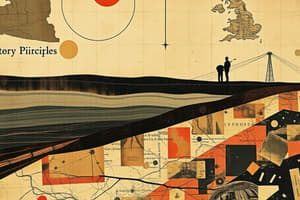Podcast
Questions and Answers
What was Steno's revolutionary thought?
What was Steno's revolutionary thought?
- The Earth's surface is made of layers.
- The Earth was created in 4004 BC.
- The Earth changes over time. (correct)
- The Earth is billions of years old.
Which of these was not a principle proposed by Steno?
Which of these was not a principle proposed by Steno?
- All rocks and minerals were originally fluid.
- Newer rocks lay on top of older rocks.
- Fossils belonged to living creatures.
- Geological events that take place today happened in the past (correct)
What is the principle of superposition?
What is the principle of superposition?
- All rocks are formed from sediments.
- Fossils can be used to date rocks.
- Older rocks lie on top of newer rocks.
- Newer rocks lie on top of older rocks. (correct)
Who calculated the age of the Earth as 6000 years old?
Who calculated the age of the Earth as 6000 years old?
What did James Hutton observe in the Scottish countryside that led him to believe that geological events are ongoing?
What did James Hutton observe in the Scottish countryside that led him to believe that geological events are ongoing?
Based on the provided geological content, what is the most likely reason for the turnover recognized by William Smith?
Based on the provided geological content, what is the most likely reason for the turnover recognized by William Smith?
What is the primary concept that Lyell's Principles of Geology can be applied to evaluate?
What is the primary concept that Lyell's Principles of Geology can be applied to evaluate?
What does the concept of 'unconformities' in geology imply about the Earth's history?
What does the concept of 'unconformities' in geology imply about the Earth's history?
How is 'fossil succession' a valuable tool for correlating the ages of strata in different locations?
How is 'fossil succession' a valuable tool for correlating the ages of strata in different locations?
What was significant about William Smith's geological map of England and Wales?
What was significant about William Smith's geological map of England and Wales?
What did Lord Kelvin initially assume about the Earth's composition?
What did Lord Kelvin initially assume about the Earth's composition?
What did Lord Kelvin NOT consider when calculating the Earth's age?
What did Lord Kelvin NOT consider when calculating the Earth's age?
What is the primary source of heat that drives geological cycles on Earth?
What is the primary source of heat that drives geological cycles on Earth?
Which of the following is NOT a type of radioactive radiation?
Which of the following is NOT a type of radioactive radiation?
Which discovery by Marie Curie revolutionized our understanding of the Earth's age?
Which discovery by Marie Curie revolutionized our understanding of the Earth's age?
What is the current estimated age of the Earth?
What is the current estimated age of the Earth?
What is the primary source of heat in the Earth's mantle and crust?
What is the primary source of heat in the Earth's mantle and crust?
Which of the following periods is NOT included in the Paleozoic Era?
Which of the following periods is NOT included in the Paleozoic Era?
According to the Principle of Superposition, which layer is younger in a sequence of sedimentary rocks?
According to the Principle of Superposition, which layer is younger in a sequence of sedimentary rocks?
Which type of rock is formed by the solidification of magma?
Which type of rock is formed by the solidification of magma?
How does the Principle of Original Horizontality help determine the relative ages of rocks?
How does the Principle of Original Horizontality help determine the relative ages of rocks?
What is the central idea behind the Principle of Uniformitarianism?
What is the central idea behind the Principle of Uniformitarianism?
Which type of rock is formed by the transformation of existing igneous or sedimentary rocks under pressure and heat?
Which type of rock is formed by the transformation of existing igneous or sedimentary rocks under pressure and heat?
According to the Principle of Cross Cutting Relations, if a fault cuts through a layer of sedimentary rock, which feature is older?
According to the Principle of Cross Cutting Relations, if a fault cuts through a layer of sedimentary rock, which feature is older?
What observation led William Smith to propose that fossils could be used to determine the relative ages of rock layers?
What observation led William Smith to propose that fossils could be used to determine the relative ages of rock layers?
What is an inclusion, in terms of geology?
What is an inclusion, in terms of geology?
What is the significance of the 'heat engine' discovered by Hutton within the Earth's interior?
What is the significance of the 'heat engine' discovered by Hutton within the Earth's interior?
What is the principle of Lateral Continuity?
What is the principle of Lateral Continuity?
Flashcards
Deep Time
Deep Time
A concept that refers to the vast time scale of Earth's geological history.
Principle of Superposition
Principle of Superposition
In geology, the principle stating that in undisturbed layers, older rocks lie beneath younger rocks.
James Usher
James Usher
An Irish Archbishop who calculated Earth's age based on biblical lineages, claiming it to be 6000 years.
Nicolas Steno
Nicolas Steno
Signup and view all the flashcards
James Hutton
James Hutton
Signup and view all the flashcards
Uniformitarianism
Uniformitarianism
Signup and view all the flashcards
Igneous Rock
Igneous Rock
Signup and view all the flashcards
Sedimentary Rock
Sedimentary Rock
Signup and view all the flashcards
Metamorphic Rock
Metamorphic Rock
Signup and view all the flashcards
Principle of Original Horizontality
Principle of Original Horizontality
Signup and view all the flashcards
Principle of Lateral Continuity
Principle of Lateral Continuity
Signup and view all the flashcards
Principle of Cross Cutting Relations
Principle of Cross Cutting Relations
Signup and view all the flashcards
Principle of Inclusions
Principle of Inclusions
Signup and view all the flashcards
William Smith's Fossil Layers
William Smith's Fossil Layers
Signup and view all the flashcards
Geologic Column
Geologic Column
Signup and view all the flashcards
Cambrian Explosion
Cambrian Explosion
Signup and view all the flashcards
Archaen Eon
Archaen Eon
Signup and view all the flashcards
Radioactivity
Radioactivity
Signup and view all the flashcards
Alpha Rays
Alpha Rays
Signup and view all the flashcards
Beta Rays
Beta Rays
Signup and view all the flashcards
Earth's Age Estimates
Earth's Age Estimates
Signup and view all the flashcards
Heat from Radioactivity
Heat from Radioactivity
Signup and view all the flashcards
Fossil Succession
Fossil Succession
Signup and view all the flashcards
Unconformities
Unconformities
Signup and view all the flashcards
Relative Dating
Relative Dating
Signup and view all the flashcards
Carboniferous Period
Carboniferous Period
Signup and view all the flashcards
Geological Map
Geological Map
Signup and view all the flashcards
Study Notes
Telling Time with the Earth
- Geologists use the Grand Canyon to exemplify principles for determining rock ages, showcasing various geological formations that illustrate processes like erosion, sedimentation, and mineral deposition.
- The principles are vital for understanding Deep Time, a concept that refers to the extensive time scale over which geological and biological processes have occurred, allowing scientists to comprehend the Earth's history beyond human timescales.
How Old is the Earth?
- James Usher (1581–1656), an Irish Archbishop, calculated the Earth's age based on genealogies derived from the Old and New Testaments, using biblical chronology to substantiate his findings.
- He determined the Earth was created on October 23, 4004 BC, which provided a fixed point in time from which his calculations could proceed.
- This estimate placed the Earth's age at approximately 6,000 years, a figure that emerged during a period when scientific methodologies were not yet advanced enough to explore deep geological timescales.
Nicolas Steno (1636-86)
- Steno, an Italian physician, observed unusual triangular stones embedded in sedimentary rocks during his studies.
- He recognized these stones as shark tooth fossils, leading to significant advancements in the understanding of paleontology and the fossil record.
- He challenged prevailing ideas about the origins of rocks and the process of the Earth's evolution during a time when mystical explanations often overshadowed scientific reasoning.
- He realized that sharks' teeth buried in sediment along with seashells had transformed into rock, illustrating fossilization and the complex processes involved in lithification.
- Proposing the principle of superposition, he noted that newer rocks generally sit on top of older ones, a foundational concept that laid the groundwork for modern stratigraphy and the understanding of relative geological chronology.
- This concept revolutionized the understanding of geological change, providing a method for establishing the ages of various rock formations.
- He proposed that fossils belonged to once-living creatures, which was a transformative idea that linked biology with geology.
- Steno also suggested that all rocks and minerals were originally in a fluid state, leading to thoughts about how geological processes are interrelated and the importance of the rock cycle.
James Hutton (1726-97)
- Hutton, a Scottish farmer and doctor, made careful observations of geological processes happening today, which provided critical insights into the ancient past.
- He realized that these natural processes, such as sedimentation and erosion, were extremely slow and often took vast amounts of time to be perceptible.
- He noted that similar processes had occurred in the past, forming the basis of his revolutionary theories regarding the Earth’s history.
- This led to the central idea behind Uniformitarianism, which states that the present is the key to the past, suggesting that we can understand historical geology by studying current earth processes.
- This principle implies that the same mechanisms operating today—like volcanic activity, sedimentation, and erosion—once operated in the past, sometimes at a relatively constant rate, allowing for a comprehensive reconstruction of the geological timeline.
Types of Rocks and Processes
-
Rocks are categorized into three primary types: igneous, sedimentary, and metamorphic, each of which is formed through different geological processes, reflecting the Earth's dynamic nature.
-
Igneous Rocks:
- These rocks are formed by the solidification of magma or lava, typically characterized by their crystalline texture.
- Intrusive rocks, such as granite, cool slowly beneath the surface, allowing large crystals to form, while extrusive rocks, like basalt, cool quickly when lava erupts and solidifies above ground, resulting in smaller crystals.
-
Sedimentary Rocks:
- Sedimentary rocks are created by the processes of compaction and cementation of small rock particles or organic material on the Earth's surface.
- Processes involving weathering, erosion, and transportation by water, wind, and ice lead to the accumulation of sediments, which are subsequently deposited in layers.
- Over time, lithification transforms these sediments through compaction and chemical actions into solid rock formations, such as sandstone or limestone.
-
Metamorphic Rocks:
- Metamorphic rocks form from existing igneous, sedimentary, or other metamorphic rocks under conditions of intense heat and pressure, causing physical and chemical transformations.
- Changes may include alterations in mineral composition, texture, and crystal structure due to these environmental factors, resulting in rocks such as schist or marble.
Charles Lyell (1797-1875)
- A British geologist, Charles Lyell is widely regarded as one of the foremost figures in the development of geological science. He authored the first comprehensive geology textbook, titled "Principles of Geology," which was published over several years between 1830 and 1833. This groundbreaking work not only introduced innovative concepts but also synthesized the earlier contributions of other geologists, making complex ideas accessible to a broader audience, thereby laying the foundation for subsequent geological studies.
- His seminal work included principles of uniformitarianism, a foundational concept in geology that asserts that the processes and patterns observed in the Earth's geological record today are consistent with those that have shaped the planet over millions of years. This idea is significant because it provides a basis for understanding geological phenomena by suggesting that the forces that have operated throughout Earth's history are uniform and that the present can serve as a key to the past. He meticulously detailed various geological processes such as erosion, which involves the wearing away of the Earth's surface; sedimentation, the accumulation of sediment that can form new rock layers; and volcanism, the eruption of molten rock from beneath the Earth's crust. Each of these processes plays a crucial role in forming the landscape and contributes to the ongoing narrative of Earth's geological history. By illustrating these processes and their interconnections, he significantly enriched the field's understanding and laid down techniques for practical application.
- Moreover, his principles allowed for the determination of the relative ages of rocks in a systematic manner, establishing essential groundwork for modern geological study. This incremental and methodical approach enabled geologists to construct a chronological framework for Earth's history, identifying key events and transitions in the geological record. Lyell's emphasis on the gradual and continuous nature of geological change underscored the importance of time as a critical factor in shaping the Earth’s processes. This notion not only reinforced the understanding that changes in the Earth's surface occur progressively, but it also highlighted the dynamic nature of our planet, illustrating that geological features are not static but are instead subject to the relentless forces of nature, continuously reshaping the landscape over vast time scales. This perspective has had a profound influence on subsequent geological research and how scientists view the interactions between different geological processes.
Principles of Geology
- Original Horizontality: This principle asserts that layers of sediment are originally deposited horizontally under the action of gravity, which helps delineate the structural integrity of sedimentary layers.
- Superposition: In a sequence of undisturbed sedimentary layers, the layer at the top is the youngest, while those below are progressively older, establishing a chronological order for geologists.
- Lateral Continuity: This principle posits that sedimentary layers typically extend horizontally in continuous sheets over large areas, aiding in correlation between different locations by recognizing similar rock strata.
- Cross-Cutting Relationships: A geological feature that cuts through another is considered younger than the one it disrupts, which assists geologists in establishing relative ages of formations.
- Baked Contacts: If a rock has been baked by the intrusion of molten material, the baked rock is older than the intrusive feature, enabling dating of geological layers based on thermal alteration.
- Inclusions: Fragments of one type of rock that are found within another are regarded as older than the rock in which they are included, further enhancing the understanding of geological history. These principles allow scientists to establish the relative ages of different rock formations, contributing to a more comprehensive geological chronology.
Unconformities
- Unconformities represent significant gaps in the geological record, indicating periods of non-deposition or erosion that disrupt normal sedimentary layering.
- Gaps can be due to non-deposition, where no sediment is laid down for a certain period; erosion, where previously deposited rock layers are removed; or deformation of layers due to tectonic forces, which can create discordant relationships between strata.
Fossil Succession
- Fossil succession is a fundamental concept in geology that helps correlate and date strata across different global locations based on the distribution of fossilized organisms.
- By examining the types and sequences of fossils found in rock layers, geologists can infer the relative ages of different strata and establish a clearer timeline of life on Earth.
The Geological Column
- The Geological Column is a representation of the Earth's history, correlating strata globally and illustrating the chronological order of rock layers, which depicts significant geological events and biological evolution.
- It helps in visualizing the relationships between age, stratigraphy, and paleontology by allowing scientists to compare different geographic locations.
Timescales in Earth's History
- The history of the Earth is divided into various timescales, encompassing eons, eras, periods, and epochs, which reflect major events and changes in geological and biological history.
- Eons are the longest subdivisions, spanning immense stretches of time; examples include the Phanerozoic, Proterozoic, Archean, and Hadean eons, each marked by significant developments in Earth's crust and life.
- Eras, periods, and epochs provide finer subdivisions within eons, allowing for a more nuanced understanding of Earth's complex history and the evolution of life.
Timescale for Life
- The history of life on Earth is closely related to geological time, beginning with the emergence of simple bacteria and single-celled organisms, which laid the foundation for all complex life forms.
- The Cambrian Explosion marks a significant increase in the diversity of life forms and the complexity of ecosystems, occurring roughly 541 million years ago, showcasing the rapid innovation of multi-cellular life.
The Age of the Earth (Lord Kelvin, 1824-1907)
- Kelvin estimated the Earth's age to be between 20 and 200 million years, proposing this estimate through calculations based on thermal dynamics and the cooling of the Earth.
- This estimate was inaccurate due to the lack of knowledge regarding radioactivity, which serves as a significant heat source within the Earth, considerably extending the age of the planet beyond Kelvin's projection.
Radioactivity
- Radioactivity is defined as the spontaneous decay of unstable atomic nuclei, a process that is critical for understanding nuclear chemistry and age determination in geology.
- Three primary types of radioactivity—alpha, beta, and gamma—were discovered, each with distinct characteristics and implications for nuclear reactions and decay processes in geological time scales.
Modern Age Estimate
- Modern estimates now place the Earth's age at approximately 4.55 billion years, a figure derived through advanced techniques such as radiometric dating, which analyzes the decay of radioactive isotopes in minerals and rocks.
Studying That Suits You
Use AI to generate personalized quizzes and flashcards to suit your learning preferences.




